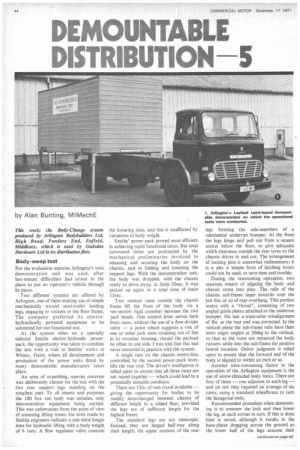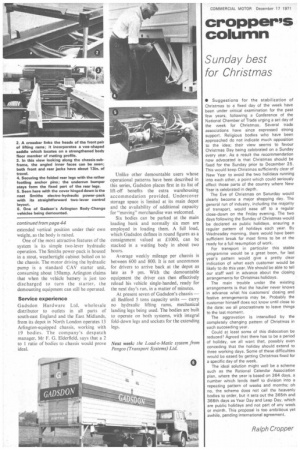DEMOUNTABLE
Page 46

Page 50

If you've noticed an error in this article please click here to report it so we can fix it.
DISTRIBUTION -5 by Alan Bunting, MIMechE
This week: the Body-Change system produced by Arlington Bodybuilders Ltd, High Road, Ponders End, Enfield, Middlesex, which is used by Gadsdon Hardware Ltd in its distribution fleet.
Body-swap test
For the evaluation exercise Arlington's own demonstration unit was used, after last-minute difficulties had arisen in the plans to put an operator's vehicle through its paces.
Two different systems are offered by Arlington, one of them making use of simple mechanically wound semi-trailer landing legs, engaging in sockets in the floor frame. The company preferred its electrohydraulically powered equipment to be submitted for our functional test.
As the system relies on a specially tailored Smiths electrohydraulic powerpack, the opportunity was taken to combine the test with a visit to Smiths' works at Witney, Oxon, where all development and production of the power units fitted by many demountable manufacturers takes place.
An area of crumbling, uneven concrete was deliberately chosen for the test with the two rear support legs standing on the roughest part. To all intents and purposes the 18ft box van body was unladen, only demonstration equipment being carried. This was unfortunate from the point of view of assessing lifting times; but tests made by Smiths engineers indicate a one-third longer time for hydraulic lifting with a body weight of 6 tons. A flow regulator valve controls the lowering time, and this is unaffected by variations in body weight.
Smiths' power-pack proved most efficient in achieving rapid functional times. But total turnround times are protracted by the mechanical preliminaries involved in releasing and securing the body on the chassis, and in folding and lowering the support legs. With the demonstration unit, the body was dropped, with the chassis ready to drive away, in 5min 30sec. It was picked up again in a total time of 6min I5sec.
Two vertical rams outside the chassis frame lift the front of the body via a vee-section rigid crossbar between the two jack heads. One control lever serves both front rams, without the use of a flow-divider valve — a point which suggests a risk of one or other jack stem straining out of line in its crossbar housing, should the payload be offset to one side. I was told that this had never occurred in practice with the system.
A single ram on the chassis centre-line, controlled by the second power-pack lever, lifts the rear end. The driver's intelligence is relied upon to ensure that all three rams are not raised together — which could lead to a potentially unstable condition.
There are 13in. of ram travel available — giving the opportunity for bodies to be readily interchanged between chassis of different height in a mined fleet, provided the legs are of sufficient length for the highest frame, The standard legs are not telescopic. Instead, they are hinged half-way along their length, the upper sections of the rear legs forming the side-members of a substantial underrun bumper. At the front the legs hinge and pull out from a square socket below the floor, to give adequate width clearance outside the rear tyres as the chassis drives in and out. The arrangement of locking pins is somewhat rudimentary; it is a pity a simple form of latching levers could not be used, to save time and trouble.
During the remounting operation, two separate means of aligning the body and chassis come into play. The rails of the chassis sub-frame taper inwards over the last 6in. or so of rear overhang. This portion mates with a "throat", consisting of two angled guide plates attached to the underrun bumper. On test a transverse misalignment of 8in at the rear end was corrected. In the vertical plane the sub-frame rails have their inner edges angled at 20deg to the vertical, so that as the rams are retracted the body runners settle into the sub-frame for positive lateral location. Driver judgment is relied upon to ensure that the forward end of the body is aligned to within an inch or so.
Another time-consuming factor in the operation of the Arlington equipment is the use of screw-threaded body locks. There are four of them — one adjacent to each leg — and on test they required an average of six turns, using a standard wheelbrace to turn the hexagonal ends.
Recommended procedure when demounting is to unscrew the lock and then lower the leg, at each corner in turn. If this is done time is saved, although it results in the base-plates dragging across the ground as the lower half of the legs assume their
extended vertical position under their own weight, as the body is raised.
One of the most attractive features of the system is its simple two-lever hydraulic operation. The Smiths power-pack is housed in a stout. wcathertight cabinet bolted on to the chassis. The motor driving the hydraulic pump is a standard CAV starter unit, consuming about 150amp. Arlington claims that when the vehicle battery is just too discharged to turn the starter, the demounting equipment can still be operated.
Service experience Gadsdon Hardware Ltd, wholesale distributor to outlets in all parts of south-cast England and the East Midlands. from its depot in North London operates 13 Arlington-equipped chassis, working with 19 bodies. The company's despatch manager. Mr F. G. Elderfield. says that a 2 to 1 ratio of bodies to chassis would prove ideal.
Unlike other demountable users whose operational patterns have been described in this series, Gadsdon places first in its list of lift-off benefits the extra warehousing accommodation provided, Undercover storage space is limited at its main depot and the availability of additional capacity for "movingmerchandise was welcomed.
Six bodies can be parked at the main loading bank and normally six men are employed in loading them. A full load, which Gadsdon defines in round figures as a consignment valued at £1000, can be stacked in a waiting body in about two hours.
Average weekly mileage per chassis is between 600 and 800. It is not uncommon for drivers to arrive back at the depot as late as 9 pm. With the demountable equipment the driver can then effectively reload his vehicle single-handed, ready for the next day's run, in a matter of minutes.
At present seven of Gadsdon's chassis—all Bedford 5 tons capacity units — carry no hydraulic lifting rams, mechanical landing legs being used. The bodies are built to operate on both systems, with integral fold-down legs and sockets for the extending legs.
































































































